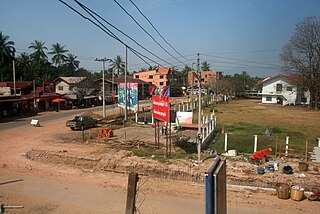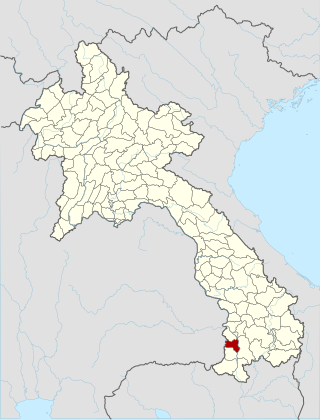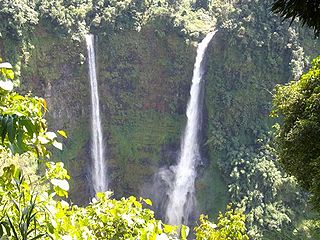External links
15°07′06″N105°48′43″E / 15.11833°N 105.8120673°E
The Champasak Provincial Museum is a local museum in Pakse, Laos. It holds the unique history of the province, which gathers all kind of artifacts and documents to chronicle the history of Champasak. The museum also holds historical photos of cultural events, foreign meetings and pictures of Kaysone Phomvihane, Nouhak Phoumsavan and Khamtay Siphandone, all from the south. There are displays of musical instruments, stelae in the Tham script dating from the 15th to 18th centuries, a water jar from the 11th or 12th century and pottery from around the province and plus a model of Wat Phu. On the higher level, it displays different ethnic clothing, along with textile and jewellery collections.
15°07′06″N105°48′43″E / 15.11833°N 105.8120673°E

Evidence for modern human presence in the northern and central highlands of Indochina, that constitute the territories of the modern Laotian nation-state dates back to the Lower Paleolithic. These earliest human migrants are Australo-Melanesians—associated with the Hoabinhian culture—and have populated the highlands and the interior, less accessible regions of Laos and all of South-east Asia to this day. The subsequent Austroasiatic and Austronesian marine migration waves affected landlocked Laos only marginally and direct Chinese and Indian cultural contact had a greater impact on the country.

Pakse is the capital and most populous city of the southern Laotian province of Champasak, and the second most populous city in Laos. Located at the confluence of the Xe Don and Mekong Rivers, it has a population of about 95,000. Pakse was the capital of the Kingdom of Champasak until it was unified with the rest of Laos in 1946.

Nong Khai province was formerly the northernmost of the northeastern (Isan) provinces (changwat) of Thailand until its eight eastern districts were split off to form Thailand's newest province, Bueng Kan province, in 2011. Nong Khai province lies in upper northeastern Thailand. Nearby provinces are : Bueng Kan, Sakon Nakhon, Udon Thani, and Loei. To the north it borders Vientiane province, Vientiane Prefecture, and Bolikhamsai province of Laos.

Ubon Ratchathani, often shortened to Ubon (อุบลฯ), is one of Thailand's seventy-six provinces lies in lower northeastern Thailand also called Isan. Ubon is about 630 km (390 mi) from Bangkok. Neighboring provinces are Sisaket, Yasothon, and Amnat Charoen. To the north and east it borders Salavan and Champasak of Laos, to the south Preah Vihear of Cambodia.
Khong Island or Don Khong is the largest island and the seat of administration in the Si Phan Don riverine archipelago located in the Mekong River, Khong District, Champasak Province, southern Laos.

Attapeu, also written as Attopu or Attapu, is the capital of Attapeu province, Laos. Its official name is Muang Samakhi Xay. It is the southernmost of provincial capitals in Laos.

Champasak or Muang Champassak is a small town in southern Laos, on the west bank of the Mekong River about 40 km south of Pakse, the capital of Champasak Province. It is the seat of the Champasak district (muang).

The French protectorate of Laos was a French protectorate in Southeast Asia of what is today Laos between 1893 and 1953—with a brief interregnum as a Japanese puppet state in 1945—which constituted part of French Indochina. It was established over the Siamese vassal, the Kingdom of Luang Phrabang, following the Franco-Siamese War in 1893. It was integrated into French Indochina and in the following years further Siamese vassals, the Principality of Phuan and Kingdom of Champasak, were annexed into it in 1899 and 1904, respectively.
The Si Phan Don is a riverine archipelago in the Mekong River, Champasak Province in southern Laos. Si Phan Don is part of Khong District, including the islands and part of the mainland in the east. Si Phan Don is dotted with numerous islands, half of which are submerged when the Mekong River is in flood. The principal islands of Si Phan Don are Don Khong, Don Som, Don Det and Don Khon. Si Phan Don borders Cambodia and historical and cultural ties link the people on both side of the border. Pakse is the closest of the bigger cities in Laos to the area.
Leptobrachium buchardi is a species of amphibian in the family Megophryidae. It is endemic to Laos and only known from the Bolaven Plateau in the Champasak Province, near its type locality within the Dong Hua Sao National Protected Area. Its natural habitat is subtropical or tropical moist montane forests. It is threatened by habitat loss.


Vat Phou is a ruined Khmer Hindu temple complex in southern Laos and one of the oldest places of worship in Southeast Asia. It is at the base of mount Phou Khao, some 6 kilometres (3.7 mi) from the Mekong in Champasak Province.

The Don Det–Don Khon railway was a 7-kilometre (4.3 mi)-long narrow-gauge portage railway on the islands of Don Det and Don Khon, part of the Si Phan Don archipelago in Champasak Province of southern Laos. Built by the Mekong Exploration Commission, the railway was operated by the Lao State Railway. It opened in 1893, and closed in 1940 or 1949.
The Champasak Stadium or Champassack Stadium is a football stadium in Pakse, Laos. It is the home of Champasak F.C and it is located just north of the Daoruang Market. It has blue and green tribunes and a proper running track around the field. The stadium is sometimes used for ceremonies and concerts. in 2010, when it had a seating capacity of 5,000, it was expanded. The stadium now holds up to 12,000 people. The stadium is named after the region Champasak, of which Pakse is the capital, Laos PDR.

Salavan is a province of Laos, located in the south of the country. Its earlier name was Saravan which was changed by Thai to Salavan in 1828. It was part of the Champasak Kingdom in an area known as Muang Mang inhabited by minorities of Mon-Khmer groups.

Champasak is a province in southwestern Laos, near the borders with Thailand and Cambodia. It is one of the three principalities that succeeded the Lao kingdom of Lan Xang. As of the 2015 census, it had a population of 694,023. The capital is Pakse, but the province takes its name from Champasak, the former capital of the Kingdom of Champasak.

IDESA Champasak United Football Club is a professional football club, based in Pakse, Laos, that plays in the Lao Premier League, the highest division in Laotian football. The club plays its home matches at the Champasak Stadium, which holds 12,000 people.

Dom Pradit is a tambon (subdistrict) located in the southernmost region of Nam Yuen district, in Ubon Ratchathani Province, Thailand. It was the same-named district in Thailand's former province, Khukhan, until being relegated to tambon and transferred to Ubon Ratchathani province in 1912.